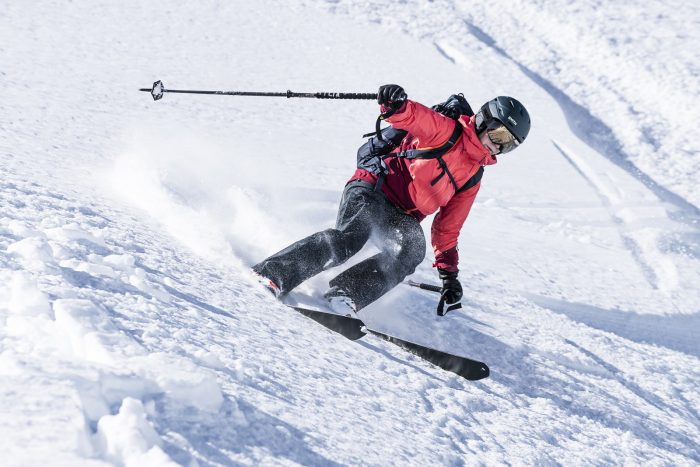EcoSki: How to make your ski kit last

Our friends at Ecoski raise awareness about how we can all meaningfully reduce our impact as skiers, help protect the very thing we all love and make it easier for snow sport enthusiasts to make better choices.
They have brought together key figures from the world of sport, environmental activism and fashion, to help them as advisors, in their journey towards a more sustainable way of life. This panel of advisors provide crucial insight, expertise and guidance through their first-hand experience and commitment to positive change. When these advisors include 4 times Olympic skier and host of Ski Sunday, Chemmy Alcott, and Polar Adventurer and Explorer Martin Hartley, you know they are serious about what they do and want to achieve.
Here they share their tips on making your ski or snow-sport kit last.

Make it last
Ski kit is not cheap and until very recently has essentially been made of some form of fossil fuel derived plastic. This means that the ski pants you wore once but don’t like any more, or the jacket that your child has outgrown, will take somewhere in the region of 500 years to decompose when it ends up in landfill.
Research has shown that extending the active life of one item of ski kit leads to a reduction in the carbon, water and waste footprint by up to 10 per cent — so taking care of your ski kit to make it last as long as possible is the best policy for both your pocket and the planet.
But, how to go about it?

Buy well and wear well
Begin with buying quality, not quantity. While not everyone can afford top-of-the-range kit, the more expensive a garment, generally the better it will be manufactured and the longer its life. As with fast fashion, if you avoid anything that you think you might not like the following season, or in two years’ time — for example, a bold print or colour, or a fur trim — you’re more likely to wear it time and again.
Look after your kit
Washing outdoor clothing in regular detergent and fabric conditioners inhibits its water resistant properties, making it less effective and at risk of degrading faster than if using appropriate aftercare. Sponge off marks or stains when they appear to help reduce the build-up of any oils or contaminants that can mask the water repellency.
Remember sunlight will degrade the properties of technical clothing too because of the harmful UV rays that can reduce fabric tear strength.
Re-proof to revive
If your kit is starting to ‘wet out’ rather than water beading up and running off the fabric, don’t despair – you just need to give it some TLC with Nikwax. Dirt, body oils, and even smoke, can all mask the water repellent coating on your gear, meaning it will soak up water. That’s why it’s key to use a technical cleaner like Nikwax Tech Wash®. Tech Wash is the best performing technical cleaner on the market that effectively cleans away dirt while maintaining the water repellency and breathability of your jacket.
Should cleaning alone not revitalise water repellency you should then re-proof your ski garments with TX.Direct®
Care for your base layers
If you have smelly base layers, don’t chuck them away! Nikwax has a cleaner and conditioner formulated specifically to remove odours from synthetic base layers and other items worn next to the skin. BaseWash cleans away all body oils and bacteria and deodorises at the same time, so you stay fresher for longer. There’s even a gentle version for woollen base layers – Wool Wash – designed to be kind to the natural properties of wool.
Nikwax Sweatproofing products also enhance the ability of your base layers to wick sweat away from your skin so you stay comfortable and your body temperature is regulated during activity. Find a selection here.
Nikwax also have the following ski related products: Glove Proof, Visor Proof and Ski Skin Proof. Rather than buy new each year, use Nikwax products to enhance the performance of your gear and you will be helping prevent the addition of textiles into landfill.

A stitch in time
Extend the life of your kit by mending any tears. Gore-Tex patches are easily bought online or, contact the original manufacturer to get a colour and fabric match. A good top tip for mending tears in down jackets is to use a sailing spinnaker tape — you literally cut a circle of the fabric, peel off the backing, place it over the hole and rub vigorously to bond the glue to the jacket. If you’re not skilled enough to replace a zipper yourself, most manufacturers have a repair service, but you could also try the local high street or EcoSki offers a repair service, too.
Don’t bin it!
At the end of the day, don’t bin it! Skiwear is designed to be durable and hardwearing so if your children have outgrown their kit or you decide it’s time for a change, why not sell your ski gear to someone else? “Preloved” ski kit sells well; just make sure it’s clean and you’re honest about any wear and tear. EcoSki sells mens’, womens’ and childrens’ pre-owned skiwear. If your kit really isn’t worth re-selling it can it be shredded and used as insulation in building materials or recycled via EcoSki’s recycling partners. Anything to keep it in circulation and living a full life.


Leave a Reply